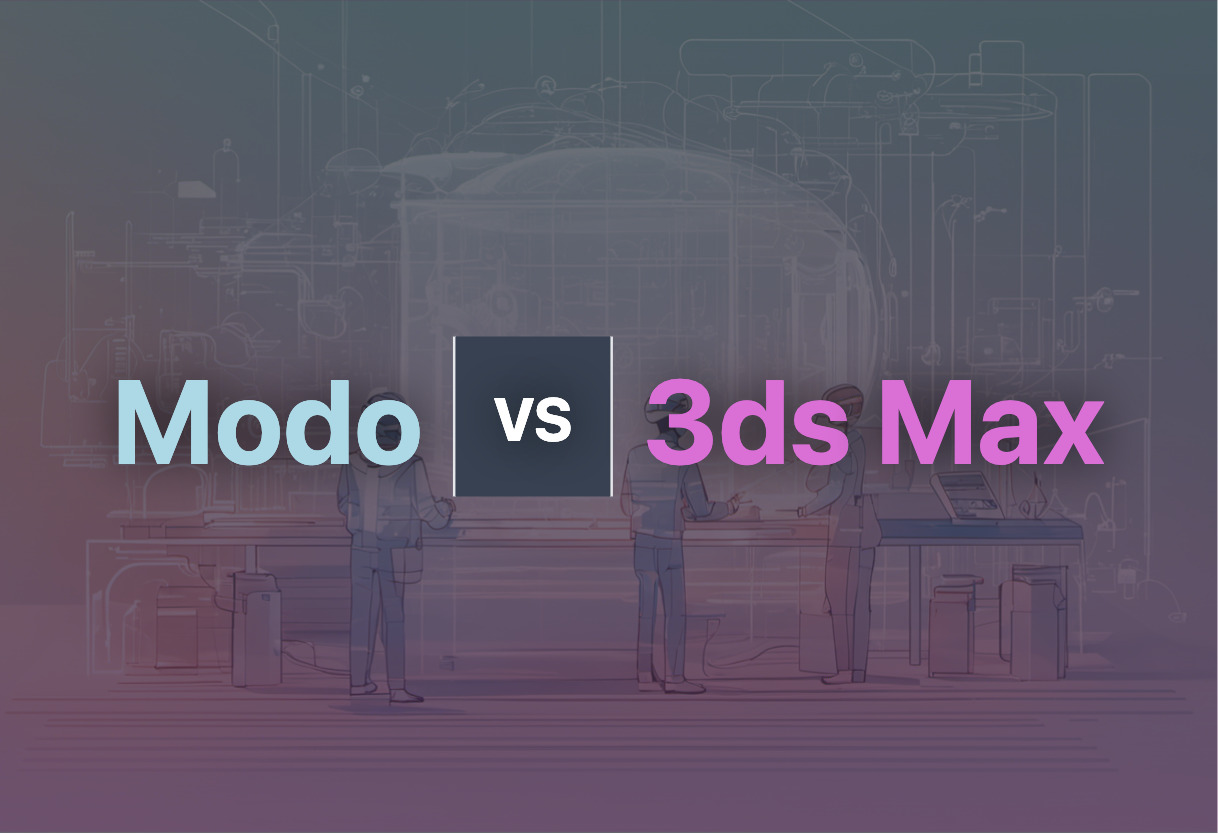For users eyeing advanced sculpting, mesh editing, and animation tools, Modo reigns supreme, typically favored by modelers, concept artists, and industrial visualizers. Conversely, 3ds Max, featuring a robust plugin architecture, is an optimal choice for developers involved in gaming, architectural presentations, and films.

Key Differences Between Modo and 3ds Max
- Compatibility: Modo supports Windows, Linux, macOS while 3ds Max is Windows exclusive.
- Use Cases: 3ds Max is popular in gaming, film, and architecture, whereas Modo is preferred in footwear design and mobile gaming.
- Customization: Modo offers extensive customization with unique features like Planar Decals, Seam Decals, while 3ds Max favors plugin architecture.
- Pricing Model: Modo follows a subscription and upgrade-based pricing model; 3ds Max offers pay-as-you-go token usage.
- Rendering: Modo is equipped with the Intel Denoiser for smart rendering; 3ds Max now has integrated cloth solver for cloth simulations.
| Comparison | Modo | Autodesk 3ds Max |
|---|---|---|
| Developer | Luxology LLC, now merged with Foundry | Autodesk Media & Entertainment |
| Purpose | 3D modeling, animation, texturing, rendering software | Used for 3D animations, models, games, images |
| Special Features | Incorporates Primitive Slice, Bridge MeshOp, Shader Tree enhancements, Intel Denoiser, Ruler/Grid MeshOp, native 3dm Rhino 7 support, and Wrap Effector | Offer options for creative texture and planar mapping, keyframing modes, integrated cloth solver and scene explorer |
| Compatibility | Compatible with Windows, Linux, macOS | Compatible only with Windows |
| Popular Industries | Footwear Design industry, mobile gaming industry | Video game development, movie production, architectural presentations, engineering design |
| Customization | Allows customization; create custom tools, gestures, scripts | Flexible plugin architecture |
| Scripting | Supports Python 3 | Built-in MAXScript, Integral Character Studio |
| Rendering Engine | Native rendering engine provides stunning render outputs in less time; compatible with V-Ray, Octane | AutoShade, now obsolete |
| Efficiency | Workflow customization, efficient animation exporting for game engines, quick render previews | support for Autodesk Vault, use of Tokens for pay-as-you-go basis |
| Training Resources | Educational resources, tutorials, and established community available | Extensive training included in educational programs across secondary and tertiary level institutes |
| Price | Subscription and upgrade-based pricing model; free trial for 30 days, affordable annual subscription cost | Has free version, other pricing on estimation basis, use of Tokens for pay-as-you-go basis |
| Used by | New Balance for footwear design and mobile game company Wooga | Used in development of high-profile films and video games; architectural and engineering design firms |
What Is Modo and Who’s It For?
Modo is an acclaimed 3D modeling, animation, texturing, and rendering software created by a team of seasoned engineers at Luxology LLC, now a part of Foundry. Originally conceived in Mountain View, California, and backed by features including n-gons and edge weighting, the application now supports Windows, Linux, and macOS. Modo 16.1, the most recent update, offers enhancements such as Planar Decals, Seam Decals, and Triplanar Texturing.
This software caters mainly to the Footwear Design industry and the mobile gaming sector. It’s a powerful tool for modelers, concept artists, and industrial visualizers who appreciate quick render previews, editable rigs, and the ability to manage a 3D project from conception to realization.
Pros of Modo
- Precise mesh editing, retopology, and advanced sculpting tools.
- Supports a variety of file types and plugins, including OCIO, FBX, USD, and Python 3.
- User-friendly subscription and upgrade pricing models.
- A variety of educational resources and tutorials.
- A highly-rated platform with a score of 4.5 across multiple platforms.
Cons of Modo
- May require advanced knowledge and training for efficient usage.
- Requires a reasonably high-performing computer to handle complex animations.
What Is Autodesk 3ds Max and Who’s It For?
Autodesk 3ds Max, formerly known as 3D Studio and 3D Studio Max, is a widely used platform for creating 3D animations, models, games, and images. Developed by Autodesk Media & Entertainment, it boasts flexible plugin architecture and operates on a Windows platform. This software is heavily employed by video game developers, movie makers, architects, and design firms.
Current formal name, “Autodesk 3ds Max” and its built-in scripting language, MAXScript, along with Scene Explorer for hierarchical scene data, make it lucrative for creatives in various industries. Highly-regarded educational institutions also include Autodesk 3ds Max in their curriculum, recognizing its comprehensive feature set for animation and modeling.
Pros of Autodesk 3ds Max
- Incorporation of multiple animation tools such as expressions, scripts, controllers, and physical simulations.
- High Degree of compatibility with Windows operating systems.
- Accessible tool for creating realistic models and animations for games and films.
- Offers a seamless integration with Autodesk Vault for asset management.
Cons of Autodesk 3ds Max
- Advanced features may require experienced handling.
- The cost of specialized plugins can escalate for customized usage.
Modo vs 3ds Max: Pricing
While Modo offers an affordable annual subscription cost, 3ds Max utilizes tokens for usage on a pay-as-you-go basis, also offering specialized plugins available for separate purchase.
Modo
Modo is offered at an affordable annual subscription cost, providing an option for upgrade-based pricing. Customizable add-ons are also available, accompanying a free trial for 30 days. Detailed educational resources and tutorials aid users in exploiting full value of the investment.
3ds Max
3ds Max utilizes a unique pay-as-you-go pricing model based on tokens. To enhance functionalities, specialized plugins can be purchased separately, providing flexibility in terms of cost and utility. Regular updates and performance improvements ensure the investment’s relevance over time.
Modo vs 3ds Max: The Conclusive Outcome
In the world of 3D modeling and animation, Modo and 3ds Max are two stalwarts offering robust features. But, which one should you pick? Let’s dissect this for different audience segments.
Game Developers
Given 3ds Max’s widespread usage in the game development industry, coupled with its plugin architecture and powerful polygon modeling, it’s a stronger contender for game developers. The offering of NURBS for smooth sphere creation amplifies its utility.

Industrial Visualizers
Modo, with its intuitive modeling tools, comes out ahead for industrial visualizers. Its advanced Boolean operations with MeshFusion and precise mesh editing capabilities facilitate manufacturing and product design.

Animation Artists and Movie Creators
3ds Max’s comprehensive animation toolkit, including expressions, scripts, list controllers, and wiring, makes it an ideal choice for animation artists and movie creators. Its integrated cloth solver for cloth simulations is a bonus.

Summing up, Modo’s dynamic mix of animation and modeling tools make it a great choice for industrial visualizers. However, for game developers and animation artists, 3ds Max’s functionality and industry footprint often take the lead. In your Modo vs 3ds Max debate, the key lies in aligning the choice with your distinct needs.
Logan Bellbrook
Content writer @ Aircada with a knack for nature & AR/VR/XR. Blogging the intersection of tech & terrain.





